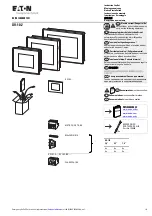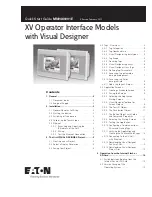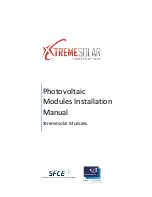
5
4
• Do not use PV modules with broken glass or torn back sheet which presents
danger of electrical shock.
• Do not handle panels in wet conditions without appropriate protection.
• Do not expose PV module to sunlight until installation to avoid unnecessary
degradation.
• Any module without a frame (laminate) shall not be considered to comply
with the requirements of UL 1703 unless the module is mounted with hardware
that has been tested and evaluated with the module under this standard or by
a field Inspection certifying that the installed module complies with the
requirements of UL 1703.
• Installation shall conform with UL standards and Safety Standards for Electri-
cal Installations.
• Do not disconnect under load.
• Do not touch conductive parts of PV modules, such as terminals, which can
result in burns, sparks and lethal shock whether or not the PV module is con-
nected.
• Do not touch the PV module unnecessarily during installation.
• Do not work in the rain, snow or windy conditions.
• Do not expose artificial sunlight to PV modules. Completely cover the PV
module with an opaque material during installation to prevent electricity from
being generated.
• Do not wear metallic rings, watchbands, ear, nose, lip rings or other metallic
objects while installing or troubleshooting.
• Only use insulated tools that are qualified for working on electrical installa-
tions.
• Follow the safety regulations for all other system components, including wire
and cables, connectors, charging regulators, inverters, storage batteries,
rechargeable batteries, etc.
• Under normal outdoor conditions the current and voltage generated will
differ from those listed on the datasheet. Current and short-circuit current
should be multiplied by a factor of 1.25 to determine component ratings.
• Only use connectors compatible with the PV module connectors. Removing
the connectors without prior authorization will invalidate the warranty.
• Do not move installed modules to another location, which may invalidate the
warranty.
Each module has three Barcode stickers and one label which have the same
unique serial no. of each module.
Barcode 1: Laminated into PV modules.
Barcode 2: Sticker on the backside of PV modules.
Barcode 3: Sticker on the middle location of long frame side.
Label: Sticker on the backside of PV modules, contains model no. and specific
information pertaining to the module.
• The fire rating of this module is valid only if this Guide is followed.
• Consult your local authority for Guidelines and requirements for building or
structural fire safety.
• Do not use PV modules near equipment or in places where flammable gases
may be generated.
• Follow local codes and laws when installing the modules
• Roof construction and installation may affect the fire safety of a building;
Improper installation may create a hazard in the event of a fire.
• Do not install module that is damaged in any way as it can pose a fire or elec
trical shock hazard.
• Do not install modules within 50m of the shoreline
UL INSTALLATION GUIDE FOR SEG
PHOTOVOLTAIC MODULE
UL INSTALLATION GUIDE FOR SEG
PHOTOVOLTAIC MODULE
Check the serial No. in the barcode with the packing list when unpacking.
Provide the PV module serial No. When you need support from SEG SOLAR
for a particular PV module.


























